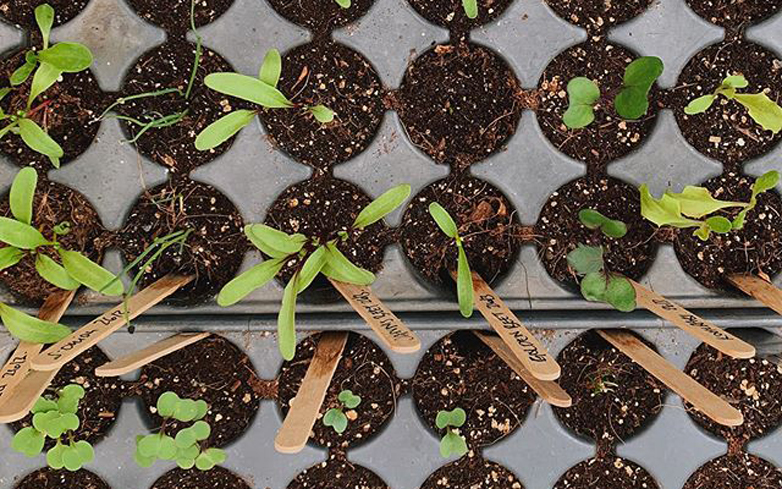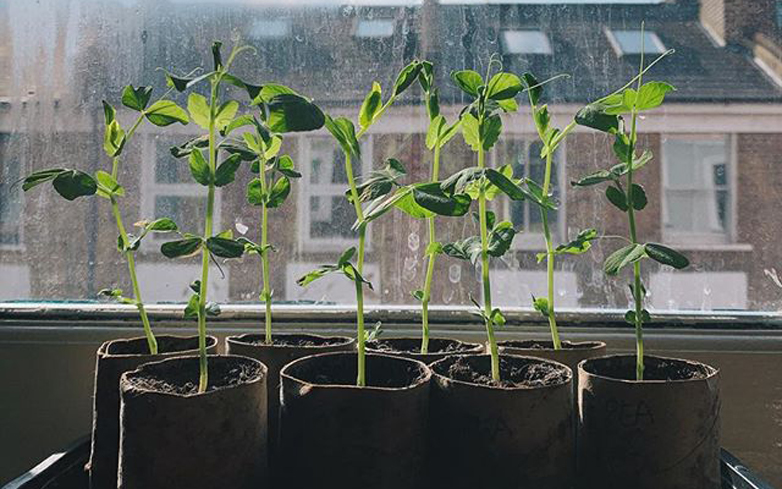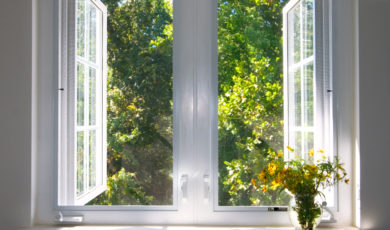An Organic Grower on Cultivating Herbs in Small Spaces

I lived in a small, one-bedroom apartment when I fell in love with growing food, so if you’re one of the many new gardeners who’s become captivated by the idea of growing your own, don’t let a little living space curb your ambition. If you’ve got a warm, sunny windowsill, balcony or porch, then you’ve got the right kind of space to grow herbs in containers.
How to Grow Annual Herbs from Seed
Growing annual herbs like parsley, dill, cilantro and basil from seed is a fairly straightforward process. Fill a 1- or 2-liter pot with multi-purpose compost nearly to the brim, and scatter seeds sparsely on the surface. Cover with a fine layer of compost, then water gently but thoroughly using a watering can with a “rose” (the attachment that looks like a shower head) to prevent your seeds from getting displaced.
Most herb seeds will germinate at room temperature although basil, being a heat-loving plant, requires some warmth to get going, so put basil plants somewhere that stays consistently above 70°F until they sprout.
The time it takes for different types of herb seeds to start growing varies from a few days to a couple of weeks so be patient! Keep the compost moist but not soaked and your seedlings will appear when they’re ready.
As soon as leaves start appearing above the compost, place your pot of new seedlings somewhere bright so that they can start growing in the light of the sun. Be ready to protect your plants if the sun gets very hot (like on a south-facing windowsill) as harsh, relentless heat can be damaging, especially when they’re still young.
I find that 5 or 6 plants is plenty in a 1-liter pot, so if many more have germinated, remove (and eat!) them so that the strongest plants have the room they need to grow.
Your annual herbs are ready to be harvested when they’ve developed at least 3 or 4 sets of true leaves. Pick the largest leaves and stems, leaving the next set of new leaves to grow on below. Basil likes to be harvested by picking the topmost rosette of leaves, as this will encourage it to grow side shoots and produce even more delicious leaves.

Rescuing Grocery Store Herb Plants
Just because growing plants from seeds is quite straightforward, doesn’t make it easy! If your seeds won’t germinate or your seedlings are struggling, don’t despair — growing herbs that someone else got started is a great option for your home herb garden.
Potted annual herbs from supermarkets are a good place to start, but they tend to be grown in a too-small container with too many plants in one pot. Carefully split up your crowded herb plant and repot 5 or 6 plants into a 1-litre container using fresh compost. Make sure your rescued plants are firmed in and steady in their new home, then harvest the largest leaves and stems and give the new growth a generous water to encourage their roots to get established.
How to Grow Perennial Herbs
If you’re looking to grow fragrant, woody herbs such as rosemary, thyme, oregano and sage, then getting hold of a mature plant from a store or garden center is the easiest way. Growing from seed is possible, but it takes a fairly long time and if your sunny place is small, there are better ways to use that precious space. Perennial herbs need watering, but less frequently than annuals, as they originate from hot, dry climates. Water them thoroughly when the compost is completely dried out and never leave them sitting in water. These plants can live many years, but benefit from a feed every few weeks while they’re growing. Repot once per year, and give your perennial herbs a good haircut in early spring — and again after they flower — to keep their growth busy and compact and the plant productive, year after year.
It is possible to grow perennial herbs from cuttings but that requires access to a parent plant, so if you’re interested in that route, I’d suggest investing in some expertly-grown specimens and finding more unusual varieties like golden oregano, purple sage or lemon thyme.
If in Doubt, Grow Mint!
Mint, being a bit of an herb garden thug, is a failsafe, foolproof herb to grow in a container. In fact, growing mint in open ground isn’t recommended as it’s such a bully that it will soon start acting like a weed and take over any ground it can find! It’s this insatiable urge to grow that makes it an excellent herb for beginner gardeners or anyone looking for an easy win.
Potted grocery store or garden center mint can be repotted in the same manner as annual herbs, but unlike annuals, the bigger the pot you give it, the more it will grow until it’s filled all available space. The leaves and stems may die back over winter, but don’t throw your mint plant out because that seemingly empty pot of compost will start growing again the following spring.
If you can’t find a mint plant, cut grocery store mint stems can actually be coaxed into growing roots — just place a bunch in a glass of water and within a couple of weeks, you’ll have viable roots ready to be planted into a pot of compost!
Now that you know how to grow your own herbs, we’re here to help you keep them fresher, longer. Chef Jane Coxwell shares her best tips here.

Meet Claire
Claire Ratinon is an organic food grower based in London. She has grown edible plants in a range of roles, from farming organically for Rovi, an Ottolenghi restaurant, to growing lettuces on an organic microsite in East London. Claire has been invited to share her growing journey and experiences in writing, talks and workshops for organizations including The Garden Museum, Royal College of Art, Bloom Magazine, Waitrose Food Magazine and The Modern House. She has also presented features for Radio 4’s Gardeners’ Question Time. Her book, How to Grow Your Dinner Without Leaving the House is due for release in 2020.





